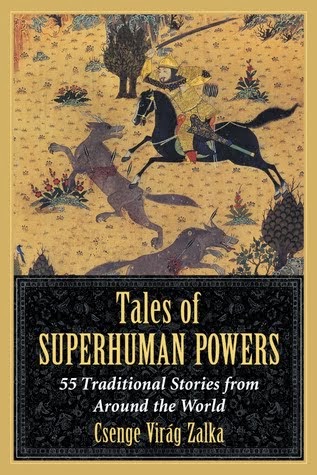It has become tradition on the blog to post a collection of folktales for International Women's Day. I've had a different theme every year: Women in war, Woman healers, Women helping women, and Badass Grandmas.
This year, I decided to collect stories about women slaying monsters. Many people cling to the belief in traditional stories monster-killing is a man's job, while women wait around helpless to be rescued. Often, this is raised as the main critique of telling folktales in "modern times" - "outdated values" and whatnot. And yet, people who complain the loudest tend to have no idea how many monster-slaying women exist in traditions around the world.
So, on this International Women's Day, let's hear it for them!
(You know the drill. Links in the titles. Image from here.)
Margaret the Giant-slayer (Ireland)
A prince sets out on his ship to seek adventure, and a girl named Margaret asks to join him. As they sail, a sea monster threatens the ship, and Margaret sacrifices herself for the crew. She manages to get away from the serpent, however, and reaches a land threatened by giants. Margaret accompanies her (returned) prince to the giants' castle, and while the prince is asleep at night, she battles the giants and kills them.
Rebeka (Transylvanian Roma tale)
There are several variants of the "Treasures of the Giant" folktale type (a.k.a. Jack and the Beanstalk) with women as protagonists. One of my favorites is the story of Rebeka, which I published on this blog in full English translation (see link). It's about a girl who rescues her sisters from a dragon, and then keeps returning to trick the monster out of various treasures. In the end, she even captures the dragon, although she doesn't kill it. (See also: Molly Whuppie)
The Ginkgo Fairy (China)
In this beautiful story a young man falls in love with a mysterious woman who turns out to be a ginkgo fairy (an old tree whose spirit took on human form). When her husband is kidnapped by evil serpents, the fairy takes up her father's sword, battles the serpents, and rescues her beloved.
The giant caterpillar (Ivory Coast)
A caterpillar as large as an elephant blocks a village road and swallows a little boy. The men of the village set out to fight the monster, but they get scared and run away. Then the women take up various household instruments and attack the caterpillar together, beating it until it's dead, and rescue the boy from its stomach.
The girl made of mud (Transylvanian Roma tale)
An old, childless couple fashions a girl from mud, and their devotion brings her to life. She soon turns out to have magic powers. First, she battles a cursed knight, then a dragon; she even follows the monster into the Underworld, fighting devils and serpents with an ax, and eventually manages to slay the dragon in a shamanistic duel of shapeshifting. (The book linked is in Hungarian).
Li Ji slays the serpent (China)
When a giant serpent threatens Fujian Province and demands maidens to devour, a brave girl named Li Ji volunteers to be sacrificed to it. She asks for a sword and a snake-hunting dog. She lures the serpent out of its cave with sweets, and kills it with the help of the dog. Then she buries the remains of the previous victims. (I blogged about this tale here.)
Durdana Chelmard (Pakistan)
Durdana is a famously clever girl; after a game of riddles, a king decides to marry her. His other wives, however, are jealous of the newcomer, and they convince their husband to abandon Durdana in the wilderness. Alone, she puts on her husband's clothes, and begins a new life as a warrior. She fights and defeats various monsters, goes on a quest, and even saves a princess. Eventually her husband shows up again, but she refuses to go back to him, returning to her parents with all he treasures instead.
Nana Miriam (Songhai, Mali/Niger)
When a monstrous hippo attacks a community, the best warriors and hunters try and fail to defeat it. It is not only ravenous, but it also melts any weapon thrown its way. Finally the chief's daughter, Nana Miriam, goes out to face the beast, and gets into an epic duel of strength and magic. When the hippo, as a last ditch effort, tries to attack her father, Nana Miriam simply grabs its hind legs, and yeets it away so hard that it is never seen again.
Aicha the Demon-hunter (Algeria)
Aicha, the clever youngest daughter of a merchant, traps and kills a man-eating ghoul. However, the ghoul curses her with its last breath, so she can never rest or stay in one place. Turning the curse into a blessing, Aicha sets out on a journey and has several adventures where she defeats sea serpents, ghouls, and werewolves with her expert skills in magic and swordsmanship. Eventually, she manages to get rid of the curse, and becomes a queen.
Hiiaka's battle with demons (Hawaii)
Hiiaka, younger sister of the Hawaiian volcano goddess Pele, has her own epic story in which she sets out on a quest and faces many obstacles. Among them, she fights Pana-ewa, a reptile-man and his army of creatures. Hiiaka has a magic skirt that summons lightning, and a knife to wield, and she puts up an epic battle against all kinds of monsters and creatures, eventually defeating them all.
Never let anyone tell you that girls can't fight monsters.
Happy International Women's Day!







.jpg)









